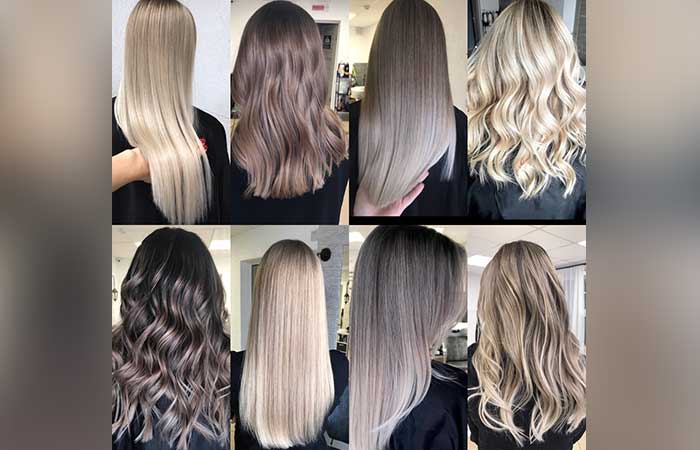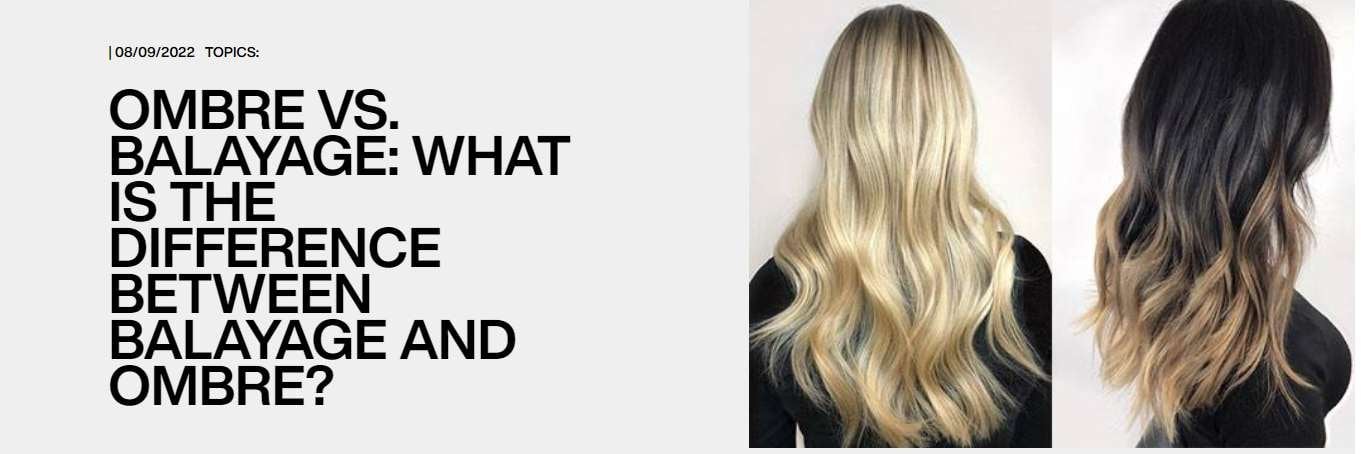The main difference between ombre and balayage is that ombre creates a darker root with lighter ends, while balayage results in a subtle color fade. Ombre showcases a horizontal color division, whereas balayage follows a vertical placement technique.
Balayage also offers the option of partial application, where color is applied from the middle to the ends, leaving the root area untouched. Balayage is known for its low maintenance and natural-looking grow-out, making it ideal for more extended periods between touch-ups.
On the other hand, ombre is a more dramatic, two-toned effect with a darker shade at the roots and a lighter shade at the lower lengths.

Types Of Hair Coloring Techniques
The main difference between ombre and balayage hair coloring techniques is that ombre gives a darker outgrowth with light ends, while balayage creates a subtle fade of color. Additionally, the color division with the ombre is more horizontal, while the balayage has a more vertical application.
Ombré
Ombré hair coloring technique is characterized by a darker outgrowth at the roots that gradually transitions into lighter ends. This technique creates a beautiful and natural-looking gradient of color in the hair. Unlike other hair coloring techniques, ombré does not involve any specific color placement or sectioning. The color transition in ombré is usually more horizontal, creating a stylish contrast.
Balayage
Balayage hair coloring technique, on the other hand, involves the application of color in a more vertical and sweeping motion. This technique creates a softer and more natural-looking effect. Balayage allows for a more customized and personalized approach to hair coloring, as the color is hand-painted onto specific sections of the hair. With balayage, the colorist can create a subtle fade of color that seamlessly blends with the natural hair color.
Different types of balayage techniques offer unique effects. One popular variation is partial balayage, where the color is applied from the upper-middle layer to the tips, leaving the layer around the roots untouched. Partial balayage is a cost-effective and time-saving option for those who want to try balayage without committing to a complete transformation.
Another critical difference between balayage and ombré is the maintenance required. Balayage tends to grow out more gracefully than ombré, making it ideal for those who want more extended periods between touch-ups. The gradual color placement of balayage helps to minimize any harsh lines or regrowth.
While balayage and ombré are often mentioned together, it’s important to note that they are not the same. Balayage offers more versatility, personalization, and a softer overall effect, while ombré creates a distinct contrast between the roots and ends.
Whether you choose ombré or balayage, both techniques can create stunning and low-maintenance looks. Consulting with a professional colorist can help you determine which technique is best suited for your hair type, desired outcome, and personal style.

Differences Between Ombré And Balayage
Ombré and balayage are both hair coloring techniques with slight differences. Ombré creates a darker outgrowth with lighter ends, while balayage creates a subtle fade of color. The color division in ombré is more horizontal, whereas in balayage, it is more vertical.
Color Placement
One of the critical differences between ombré and balayage lies in the color placement. With ombré, the color transition starts at the roots and gradually becomes lighter towards the ends. This technique creates a darker outgrowth with lighter ends, giving a more dramatic effect. On the other hand, balayage involves more vertical color placement. The color is hand-painted onto specific sections of the hair, creating soft and natural-looking highlights that blend seamlessly throughout the hair.
Dimension
Dimension, ombré, and balayage offer different effects. Ombré tends to have a more noticeable contrast between the dark roots and light ends, creating a bolder and more defined look. This technique is ideal for those who want a striking, high-contrast style. Balayage, on the other hand, offers a more subtle and blended effect. The color is strategically placed to add depth and dimension to the hair, creating a more natural-looking, sun-kissed effect.
Maintenance
In terms of maintenance, both ombré and balayage are relatively low-maintenance options. However, there are some differences to consider. Since the color transition in ombré starts at the roots, the regrowth can be more noticeable, requiring more frequent touch-ups. Balayage, on the other hand, has a softer and more gradual color placement, making the regrowth less obvious. This means you can go longer between touch-ups, saving time and money in the long run.
Choosing Between Ombré And Balayage
When it comes to choosing between ombré and balayage, it’s essential to understand the differences and consider your hair color goals. Both techniques offer stunning hair color effects, but they have distinct characteristics that may suit different hair types and desired results. Let’s dive deeper into what sets them apart.
Hair Color Effect
Ombré and balayage both create a beautiful gradient effect in the hair. However, the critical difference lies in the way the color is distributed. Ombré typically involves a darker root area that gradually fades into lighter ends, creating a more horizontal color transition. On the other hand, balayage offers a more vertical placement of color, resulting in a subtle and seamless blend from root to tip.
Suitability For Different Hair Types
When it comes to suitability for different hair types, both ombré and balayage can be versatile options. However, certain factors may influence the choice between the two techniques. For example, ombré works particularly well for darker hair types, as the shadowy root area blends seamlessly with the lighter ends. On the other hand, balayage can be an excellent choice for adding dimension and depth to lighter hair shades.
If you have fine or thin hair, balayage can create the illusion of thicker hair by adding subtle highlights strategically placed throughout the hair. For those with thicker hair, ombré can provide a more dramatic contrast and visual interest.
It’s essential to consider your desired maintenance level as well. Ombré tends to grow out more naturally, making it a suitable choice for those who prefer a low-maintenance look. Balayage, on the other hand, may require touch-ups more frequently to maintain the desired color placement.
In conclusion, both ombré and balayage offer unique hair color effects and can be tailored to suit different hair types and preferences. Understanding the differences between these techniques and discussing your goals with a professional hairstylist can help you make an informed decision and achieve the perfect look for you.

Frequently Asked Questions On Ombre Vs. Balayage: Types And Difference
What Is The Difference Between Ombre And Balayage?
The main difference between ombre and balayage is the color placement and blending technique. Ombre creates a darker root with lighter ends, while balayage creates a more subtle, blended fade of color. Ombre is horizontally focused, while balayage is applied vertically.
Are There Different Types Of Balayage?
There are different types of balayage, such as partial balayage, where color is applied from the middle to the ends, leaving the roots untouched. Balayage also lasts longer than ombre and provides a more subtle fade of color. Balayage is a highlighting technique, while ombre is a hair color effect.
Does Balayage Or Ombre Last Longer?
Balayage lasts longer than ombre, making it perfect for those who want longer intervals between touch-ups.
What Is The Difference Between Blue Ombre And Balayage?
The difference between blue ombre and Balayage is that blue ombre refers to the color technique where the hair transitions from dark to light with a blue hue. At the same time, Balayage is a highlighting technique where color is painted onto sections of hair for a sun-kissed look.
Conclusion
To sum it up, understanding the difference between ombre and balayage is crucial when it comes to hair coloring techniques. The key distinction lies in the way the color is applied and the effect. Ombre creates a darker outgrowth with lighter ends, while balayage gives a subtle fade of color.
Additionally, there are different types of balayage, such as partial balayage, which is less time-consuming and cheaper. Ultimately, both techniques offer low-maintenance hairstyles that can enhance your overall look.
DIY hair oils are some of the most important ingredients to have in your beauty arsenal. They add shine, manage frizzy hair, and help improve your hair health.